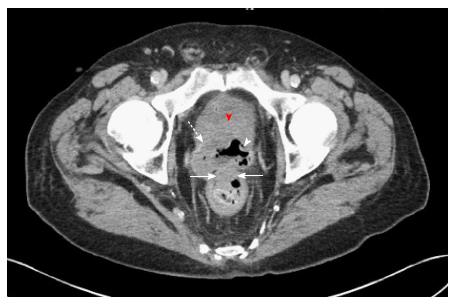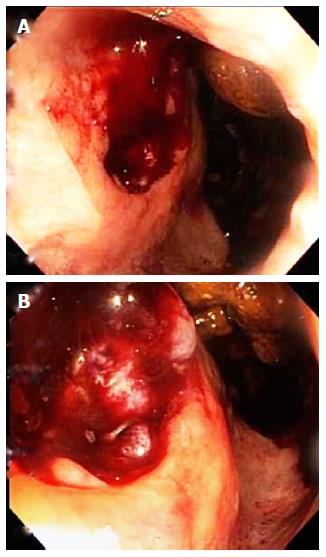Copyright
©The Author(s) 2017.
World J Gastrointest Endosc. Jun 16, 2017; 9(6): 282-295
Published online Jun 16, 2017. doi: 10.4253/wjge.v9.i6.282
Published online Jun 16, 2017. doi: 10.4253/wjge.v9.i6.282
Figure 1 Abdominopelvic computed tomography angiography demonstrating thickened bladder wall (red arrowhead), with adjacent prostate margin (dashed arrow).
Air-filled cavity within the prostate gland (white arrowhead), is consistent with the known bladder urothelial carcinoma penetrating, via the prostate, into the rectum (horizontal solid arrows). The colonoscopic findings (Figure 2) strongly support this mechanism of cancer spread.
Figure 2 Colonoscopy reveals, just above the anorectal margin (line between pale skin and red mucosa), a multinodular, friable, 2.
5-cm-wide, hemorrhagic, mass that replaces the normal prostate and overlying rectum (A, B). Tissue surrounding the lesion appears to be normal. Biopsy of this mass revealed bladder urothelial carcinoma. The finding of bladder urothelial carcinoma in the normal location of the prostate and overlying rectum, just inferior to the bladder cancer, is consistent with direct extension of bladder urothelial carcinoma into the immediately adjacent prostate and its overlying rectal mucosa. This cancer location is highly consistent with the abdominopelvic computed tomography findings (Figure 1).
Figure 3 Histologic examination and immunohistochemical analysis.
A: Low power photomicrograph shows segments of detached poorly differentiated cancer (arrows), amidst segments of normal rectal mucosa (arrowhead). Right inset shows high power photomicrograph of polygonal tumor cells (HE stain) that have a histologic appearance characteristic for urothelial carcinoma. Immunohistochemistry confirmed the urothelial histology of the cancer (Figure 3B and C); B: Left: Immunohistochemistry for cytokeratin-20 demonstrates positive staining of tumor cytoplasm. Right: Immunohistochemistry for GATA-3 demonstrates positive staining of tumor cell nuclei. This immunohistochemical profile indicates that the rectal mass is of urothelial origin; C: Immunohistochemistry for CDX-2 shows negative staining of tumor cell nuclei, indicating that this tumor is not colonic adenocarcinoma. Right inset is a control of normal colonic glands set on the same slide which demonstrates positive nuclear staining for CDX-2.
- Citation: Aneese AM, Manuballa V, Amin M, Cappell MS. Bladder urothelial carcinoma extending to rectal mucosa and presenting with rectal bleeding. World J Gastrointest Endosc 2017; 9(6): 282-295
- URL: https://www.wjgnet.com/1948-5190/full/v9/i6/282.htm
- DOI: https://dx.doi.org/10.4253/wjge.v9.i6.282















